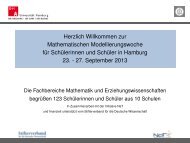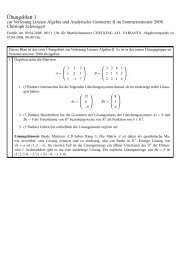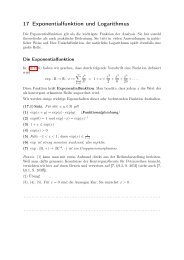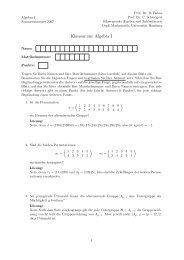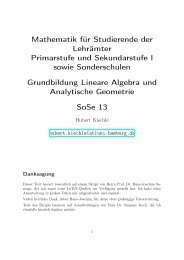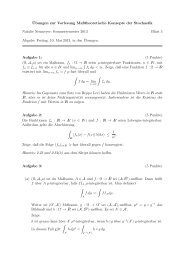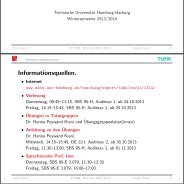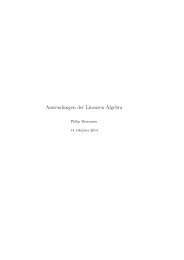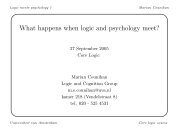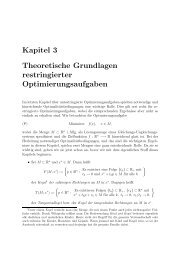pdf file
pdf file
pdf file
Create successful ePaper yourself
Turn your PDF publications into a flip-book with our unique Google optimized e-Paper software.
For the special case of the energy, we have<br />
∑<br />
ɛ λ (ϕ)e −βɛ λ(ϕ)<br />
E β,λ [ɛ] =<br />
states<br />
Z(β, λ)<br />
= − ∂ ln Z(β, λ)<br />
∂β<br />
It is thus an important goal to compute the partition function. To this end, we introduce<br />
Boltzmann weights<br />
We then get<br />
R kl<br />
ij (β, λ) = e −βɛkl ij (λ) .<br />
e −βɛ λ(ϕ) = ∏<br />
Consider the contribution of the first line to the partition function where we temporarily allow<br />
different values for the leftmost and rightmost bond:<br />
atoms<br />
R kl<br />
ij .<br />
It equals<br />
i 1<br />
k 1 k 2 k 3 k N−1 k N<br />
. . .<br />
r 1 r 2 r 3 r N−1 i ′ 1<br />
l<br />
. . .<br />
1 l 2 l 3 l N−1 l N<br />
T i′ 1 l 1...l N<br />
i 1 k 1 ...k N<br />
= ∑<br />
R r 1l 1<br />
i 1 k 1<br />
R r 2l 2<br />
r 1 ...r N−1<br />
r 1 k 2<br />
. . . R i′ 1 l N<br />
r N−1 k N<br />
(12)<br />
To eliminate indices, we introduce a complex vector space V freely generated on the set<br />
{1, . . . , n} with basis {v 1 , . . . v n } and a family of endomorphisms<br />
R = R(β, λ) : V ⊗ V → V ⊗ V<br />
v i ⊗ v j ↦→ ∑ k,l Rkl ij v k ⊗ v l .<br />
Definition (12) leads to the definition of the endomorphism T ∈ End (V ⊗ V N ) with<br />
T = R 01 R 02 R 03 . . . R 0n .<br />
Here we understand that the endomorphism R ij acts on the i-th and j-th copy of V in the<br />
tensor product V ⊗ V N .<br />
Periodic boundary conditions imply for the sum over the first line<br />
Tr V (T ) l 1...l N<br />
k 1 ...k N<br />
.<br />
This endomorphism is called the row-to-row transfer matrix. To sum over all M lines, we take<br />
the matrix product and then the trace so that we find:<br />
Z = tr V ⊗N (tr V (T )) M .<br />
This raises the problem of understanding the eigenvalues of the endomorphism Tr V (T ) ∈<br />
End(V ⊗N ): in the thermodynamic limit, we take M → ∞ so that Z ∼ κ M N with κ N the<br />
eigenvalue with the largest modulus.<br />
As usual in eigenvalue problems, we try to find as many endomorphisms of V ⊗N as possible<br />
commuting with Tr V (T ) which allows us to solve the eigenproblem separately on eigenspaces<br />
of these operators.<br />
Definition 4.3.1<br />
98




